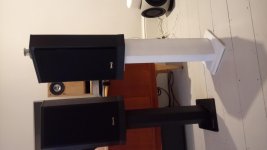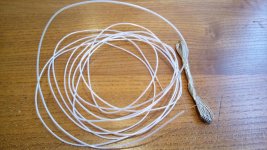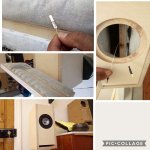Thanks Nanook for this detailed explanation, the bullet points you wrote put it in to perspective for me.
For my speaker build i do want to make sure i use the correct cable and connectors.
I can understand what Dave is talking about, as such i want to implement these little details into my future speaker builds.
i was doing some research on what is the best conductor of electricity:
Material IACS (International Annealed Copper Standard) Ranking Metal % Conductivity* 1 Silver (Pure) 105% 2 Copper 100% 3 Gold (Pure) 70% 4 Aluminum 61% 5 Brass 28% 6 Zinc 27% 7 Nickel 22% 8 Iron (Pure) 17% 9 Tin 15% 10 Phosphor Bronze 15% 11 Steel (Stainless included) 3-15% 12 Lead (Pure) 7% 13 Nickel Aluminum Bronze 7% * Conductivity ratings are expressed as a relative measurement to copper. A 100% rating does not indicate no resistance.
Silver comes on top, so my thoughts were why don't i buy a couple of meters of 99.99% silver wire 18AWG and make my own cables? I can source a good dielectric teflon/silicon type sleeving.
I really believe cables, what they are made from, how they are made can make a difference on the overall sound of ones system.
I spent time making cables and buying high end cables for my own system, but when building these speakers i did not put as much thought into the connectors and cabling.
As for spikes and materials just something i have to try and play with to see if it suits my listening needs, i have installed removable spikes on the enclosures to try them. I have some lovely atacama se24 stands, these are solid and allow sand to be used in them.
I have them thick granite which i will cut and use and try between the speakers and stands. If anything i can measure each setup on RoomEQ and see if it makes a difference.
For my speaker build i do want to make sure i use the correct cable and connectors.
I can understand what Dave is talking about, as such i want to implement these little details into my future speaker builds.
i was doing some research on what is the best conductor of electricity:
Material IACS (International Annealed Copper Standard) Ranking Metal % Conductivity* 1 Silver (Pure) 105% 2 Copper 100% 3 Gold (Pure) 70% 4 Aluminum 61% 5 Brass 28% 6 Zinc 27% 7 Nickel 22% 8 Iron (Pure) 17% 9 Tin 15% 10 Phosphor Bronze 15% 11 Steel (Stainless included) 3-15% 12 Lead (Pure) 7% 13 Nickel Aluminum Bronze 7% * Conductivity ratings are expressed as a relative measurement to copper. A 100% rating does not indicate no resistance.
Silver comes on top, so my thoughts were why don't i buy a couple of meters of 99.99% silver wire 18AWG and make my own cables? I can source a good dielectric teflon/silicon type sleeving.
I really believe cables, what they are made from, how they are made can make a difference on the overall sound of ones system.
I spent time making cables and buying high end cables for my own system, but when building these speakers i did not put as much thought into the connectors and cabling.
As for spikes and materials just something i have to try and play with to see if it suits my listening needs, i have installed removable spikes on the enclosures to try them. I have some lovely atacama se24 stands, these are solid and allow sand to be used in them.
I have them thick granite which i will cut and use and try between the speakers and stands. If anything i can measure each setup on RoomEQ and see if it makes a difference.
... there are merits to many. Remember though that a cable has resistance (more correctly impedance), inductance and capacitance. Any two will create a filter of some sort.
To me this is often the crux of the argument many who suggest that there are no differences in cable fail to "see". Now as to the ability for one to hear differences or the validity of whether one cable is superior to another I take the position that "the beauty is in the eye of the beholder". I've done cable comparisons and 'quality" reviews when I wrote for an online audio 'zine. To me there are noticeable differences, but it truly depends on how transparent one's system is and how well you know its signature sound.
I also believe that there is a lot of hype in the high performance cable aftermarket. SO for any with questions regarding cabling I offer the following ideas (sorry for the bulleted lists, Dave. I know you hate them) which I have stated before and which it seems that most cable designers can agree:
- use a cable with good quality conductors using appropriate geometry;
- use a cable with the best dielectric possible;
- use a cable that uses good (if not the best) connectors (if any) you can afford. Sometimes bare wire is preferred;
- use a cable that has been carefully constructed using good soldering practices (quality and pride in workmanship);
- use a cable that is shielded if required (YMMV).
Most wire can be suitable based on the quality of conductors. Even cheap cables can now boast 99.999% purity. If copper, tin the ends (for speaker cable) and just use the tinned ends in a binding post. for ICs, tin the ends and ensure the connectors have been properly heated to allow for a good electrical joint to occur. Buy the best connectors you can afford. These can often minimize the likelihood of a bad fir for an RCA or bullet connector. Argue which is best all you want, but there have been enough industry 'standards' that have been used universally and are universally 'good'.
The use of good conductors, et al, and good mechanical connectors can be for naught unless the folks terminating the cables care about the quality of their work, ensuring that no cold solder joints exist. I personally care not whether the 'terminator' is a Chinese (or any other Asian) factory worker, or one in the US, Europe, or Canada (or elsewhere), but I do care that they are given the time to build the cables correctly with appropriate care.
Shields can have a profound effect on the sound as well. Some cables need the shield, some don't (it is RF and system dependent). Anything that one can do to help minimize these problems if apparent is a good thing.
And now to the one point that many may choose to ignore... the dielectric. Dielectrics have a profound effect on electrical fields, and it is these fields that transport the signals. Te lower the dielectric constant the less the fields are perturbed and the more intact the signal will be.
and now... spikes? sorbothane? What to use between a speaker and whatever is supporting it.
Last edited:
Jewelry Findings | United States | Myron Toback Inc.
Good supplier of silver wire.
Appropriately sized teflon tubing can be found easily on ebay, or maybe McMaster-Carr.
Good supplier of silver wire.
Appropriately sized teflon tubing can be found easily on ebay, or maybe McMaster-Carr.
Thanks pcgab, there is some good sources here in the UK, so ill do my best to find a good company.
Considering its a 4inch alpair driver what circumference in mm or AWG should the wire be?
Considering its a 4inch alpair driver what circumference in mm or AWG should the wire be?
Jewelry Findings | United States | Myron Toback Inc.
Good supplier of silver wire.
Appropriately sized teflon tubing can be found easily on ebay, or maybe McMaster-Carr.
I'd scrounge around for at least something like the old Radio Shack 5% silver bearing solder. My personal favorite is the old Cardas Quad Eutectic - I bought a one pound roll at least 10yrs ago, and have hardly touched it. PM me
Did the Cardas qe formula change? I've been using it for awhile and it seems to work quite well. It's not cheap, but I wouldn't consider it expensive per se. I suppose if I was using quite a lot of it I would likely look for something cheaper.
Considering its a 4inch alpair driver what circumference in mm or AWG should the wire be?
I’d suggest 24g solid. Any skinnier and it tends to break too easily.
dave
This is seriously going off the rails IMO.
Notice, no measurements, and no double blind tests as proof. How much better? and for what cost?
Speaker Cable Gauge (AWG) Guidelines & Recommendations | Audioholics
Testing audiophile claims and myths | Head-Fi.org
You have REW + UMIK so you can make these measurements. Prove it to yourself, using identical setups with different wire. Please post the comparative speaker results if you end up buying something exotic.
Regular copper 18-14 awg for typical distances (<20ft), typical power levels (<50w), and typical speakers (6-8ohm).
Notice, no measurements, and no double blind tests as proof. How much better? and for what cost?
Speaker Cable Gauge (AWG) Guidelines & Recommendations | Audioholics
Testing audiophile claims and myths | Head-Fi.org
You have REW + UMIK so you can make these measurements. Prove it to yourself, using identical setups with different wire. Please post the comparative speaker results if you end up buying something exotic.
Regular copper 18-14 awg for typical distances (<20ft), typical power levels (<50w), and typical speakers (6-8ohm).
Now its all very well buying pure silver wire, can i just use normal electrical solder to solder these to the connectors?
With silver you need to use solder with silver in it, the usual receipes have 2-4%.
dave
Notice, no measurements, and no double blind tests as proof. How much better? and for what cost?
Current measurements are typically too crude to pull out these kind of differences. Valid double blind tests are very hard to do, and the commonly touted ABX is statistically so poor it is only of use when it shows a difference.
You have to trust your ears, and besides they are all that matters. If he wants to spend the money, fine. I personally am happy with my solid core, cryo-treated, teflon insulated 24g.
dave
Did the Cardas qe formula change? I've been using it for awhile and it seems to work quite well. It's not cheap, but I wouldn't consider it expensive per se. I suppose if I was using quite a lot of it I would likely look for something cheaper.
Well, I can certainly remember some comments on this a while back - either re a change in the alloy ratios, or formulation of flux. Like I said, I bought my roll quite some time ago, and it's by far the most pleasurable to use - flows wonderfully.
And not to dissuade vishalk from reaching his own conclusion, among countless audiophile tweakery over the years, I've used solid silver for both speaker wires and interconnects, and failed to achieve nirvana, or even satori from the experience.
off topic... wire again...
I have friends who swear by Cu. And some that swear by Ag. And others yet that feel Ag tinned Cu is the best. Perhaps carbon nanotubes cultivated in outer space and infused with Yak **** is best?
I suspect that some can hear the difference, while others cannot. If you cannot hear a difference I'd opt for the least expensive option in terms of conductors (but tinning the ends of any wire can help reduce the likelihood of oxidation). I think there are few areas that (regardless of what conductor one uses) that all should agree. There are differences in dielectric. Teflon is the best solid that we have with the lowest dielectric constant. This tells us that this dielectric will disturb the E field the least (it is the field that carries the signal, not the conductor). I am also a fan of being consistent within a system regarding cabling. If you use CU conductor in your IC's, use the same material for speaker cables. If Ag ICs are used, used Ag speaker cables.
One can argue the merits of a particular conductor, but it is everything taken together that is critical. Good conductors, using good dielectrics, good mechanical connectors, put together by people who have good skills (so as to be consistent from cable to cable) and care what they are doing.
and back to footers/isolation devices. It is so important what one is trying to do with a component (in this case loudspeakers) that each component must be looked at completely separately. A couple of years ago I had 16 people in my tiny living room dancing. We were using my suspended Oracle Alex Mk II turntable. I have it sitting on a bamboo cutting board, which sits on 4 Audio Technica isolating feet on top of a sand filled Target Delta 5 stand. The TT should have been having fits (the floors were shaking under foot) but the it kept spinning without a single skip (the floors in my tiny 100 year old house are about as spongy as any could ever be). Without all of these coupling and isolating devices, I know the table would have skipped (in the past it had...)..
Just remember what you are trying to accomplish : isolation or mass coupling.
I have friends who swear by Cu. And some that swear by Ag. And others yet that feel Ag tinned Cu is the best. Perhaps carbon nanotubes cultivated in outer space and infused with Yak **** is best?
I suspect that some can hear the difference, while others cannot. If you cannot hear a difference I'd opt for the least expensive option in terms of conductors (but tinning the ends of any wire can help reduce the likelihood of oxidation). I think there are few areas that (regardless of what conductor one uses) that all should agree. There are differences in dielectric. Teflon is the best solid that we have with the lowest dielectric constant. This tells us that this dielectric will disturb the E field the least (it is the field that carries the signal, not the conductor). I am also a fan of being consistent within a system regarding cabling. If you use CU conductor in your IC's, use the same material for speaker cables. If Ag ICs are used, used Ag speaker cables.
One can argue the merits of a particular conductor, but it is everything taken together that is critical. Good conductors, using good dielectrics, good mechanical connectors, put together by people who have good skills (so as to be consistent from cable to cable) and care what they are doing.
and back to footers/isolation devices. It is so important what one is trying to do with a component (in this case loudspeakers) that each component must be looked at completely separately. A couple of years ago I had 16 people in my tiny living room dancing. We were using my suspended Oracle Alex Mk II turntable. I have it sitting on a bamboo cutting board, which sits on 4 Audio Technica isolating feet on top of a sand filled Target Delta 5 stand. The TT should have been having fits (the floors were shaking under foot) but the it kept spinning without a single skip (the floors in my tiny 100 year old house are about as spongy as any could ever be). Without all of these coupling and isolating devices, I know the table would have skipped (in the past it had...)..
Just remember what you are trying to accomplish : isolation or mass coupling.
Pure Silver wire, silver solder and Speaker stands.
Bought some second hand speaker stands, bargain at £20. Used some pastikote white matt spray paint to tidy them up, a few more coats will look like new.
Silver wire and solder arrives ready to be carefully soldered making good clean connections.
Bought some second hand speaker stands, bargain at £20. Used some pastikote white matt spray paint to tidy them up, a few more coats will look like new.
Silver wire and solder arrives ready to be carefully soldered making good clean connections.
Attachments
With silver you need to use solder with silver in it, the usual receipes have 2-4%.
dave
Never understood this, what difference does 2% silver make? What happens if you use normal solder? Does it make any difference if it's silver plate? Why is it ok to use normal solder with gold plate?
Bought some second hand speaker stands
If the pillar is hollow fill it up with sand or kitty litter or some such.
dave
If the pillar is hollow fill it up with sand or kitty litter or some such.
dave
Thanks Dave it came filled with sand. Fairly weighty!
Slims done, new silver wire soldered and enclosures ready go be glued and finished.
Go, go, go!
- Status
- This old topic is closed. If you want to reopen this topic, contact a moderator using the "Report Post" button.
- Home
- Loudspeakers
- Full Range
- Trapezoid mini Onken&Slim GR dMar-Ken builds


